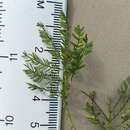tr
kırıntılardaki isimler


Desmanthus leptolobus, known as prairie mimosa, prairie bundleflower or slenderlobe bundleflower,[2] is a flowering plant of the genus Desmanthus. It is native to Kansas, Oklahoma, and Texas and has spread to Missouri and New Mexico.[3] It is often locally abundant over large expanses of rolling prairie.[4]
Desmanthus leptolobus grows easily from seed in USDA Hardiness Zones 5–8, handling freezes to ~-20 °C. The species is usually erect when young, trailing/spreading as it ages. Few to many, red-green trailing stems up to roughly a metre in length and tapering cylindrical taproots up to a metre and a half by one to two centimetres in diameter. The leaves are normally two and a half centimetres to six centimetres long and the curved, pointed leaflets are approximately two to five centimetres long by five to ten millimetres wide. The latter are narrowly elliptic to linear and arranged in 15 to 25 pairs.[5]
Seeds are thinner and more elongated than those of the closely related species Desmanthus illinoensis.[6]
Root bark of D. leptolobus has been found to contain a psychedelic compound called N,N-DMT and other related tryptamines. While its only reported quantitative analysis found concentrations of 0.14% of N,N-DMT (lower than has been found in Desmanthus illinoensis), one person documented a "subjectively stronger response" than D. illinoensis.[7][8] Desmanthus species have been found to have variable concentrations of N,N-DMT.[7]
The species is an early-appearing component of land-reclamation vegetation, rapidly disappearing once shrub and tree species establish.[5]
Desmanthus leptolobus, known as prairie mimosa, prairie bundleflower or slenderlobe bundleflower, is a flowering plant of the genus Desmanthus. It is native to Kansas, Oklahoma, and Texas and has spread to Missouri and New Mexico. It is often locally abundant over large expanses of rolling prairie.
Desmanthus leptolobus (Torrey & A.Gray) chiamata anche Praire mimosa, è una pianta originaria delle grandi pianure sud-centrali degli USA. Cresce principalmente su terreni argillosi e calcarei ed anche su sabbie e argille sabbiose in aree forestali erbose e aperte.[1]
Si presenta come una piccola erba distesa, perenne, legnosa alla base. Si propaga fino a un metro di lunghezza, con steli striscianti. La radice principale è lunga dai 40 ai 90 cm, del diametro di 1–2 cm nelle piante adulte, cilindrica, leggermente affusolata, legnosa, a volte nodosa, con una scorza di colore da grigio-bruno a rossastro bruno, spessa e sugherosa.
Le foglie sono lunghe dai 2 ai 7 cm, tutte glabre. Le foglioline sono quasi sessili, in 15-22 coppie, lunghe 2-5 mm larghe 1 mm. Sono incurvate, da quasi ellittiche a lineari, arrotondate obliquamente alla base, terminanti in una punta, glabre ad eccezione di peli bianchi appressati distribuiti in forma sparsa lungo il margine. Le teste fiorifere sono poche, una per ogni ascella fogliare, ciascuna contenente 4-10 fiori, ciascuno con un calice obovato-triangolare. . I petali sono verde pallidi o bianchi, glabri o lineari, lunghi 3.0-5.0 mm e larghi 0.3-0.5 mm.[2]
Le piante del genere desmanthus sono una buona fonte di foraggio e le sementi forniscono cibo a uccelli, roditori e piccoli animali, specialmente nelle zone più aride.
Nel 1992 Johnny Appleseed ha scoperto la presenza dello 0.14% di DMT nella scorza di radice secca. Sempre nel 1992 altri esperimenti hanno riprodotto una forma di ayahuasca usando 45 mg di scorza di un isolato purificato di radice di D. leptolobus combinato con 125 mg di un estratto di Peganum harmala.[3]
Desmanthus leptolobus (Torrey & A.Gray) chiamata anche Praire mimosa, è una pianta originaria delle grandi pianure sud-centrali degli USA. Cresce principalmente su terreni argillosi e calcarei ed anche su sabbie e argille sabbiose in aree forestali erbose e aperte.
Desmanthus leptolobus là một loài thực vật có hoa trong họ Đậu. Loài này được Torr. & A.Gray miêu tả khoa học đầu tiên.[1]
Desmanthus leptolobus là một loài thực vật có hoa trong họ Đậu. Loài này được Torr. & A.Gray miêu tả khoa học đầu tiên.